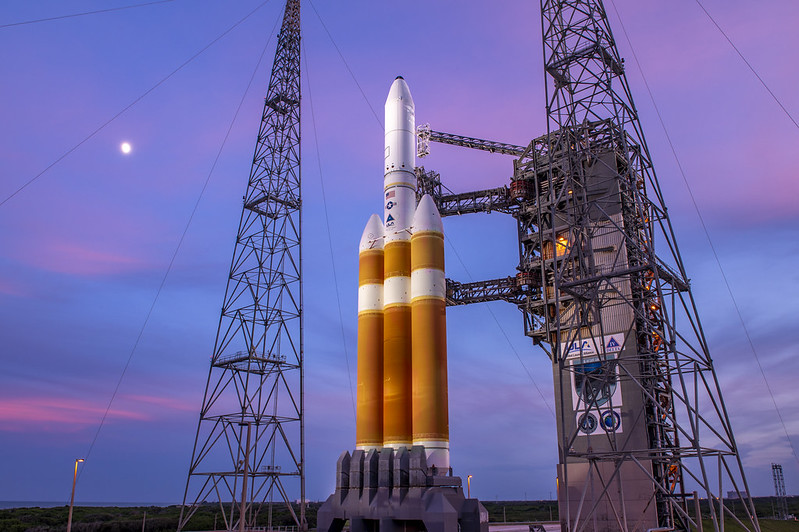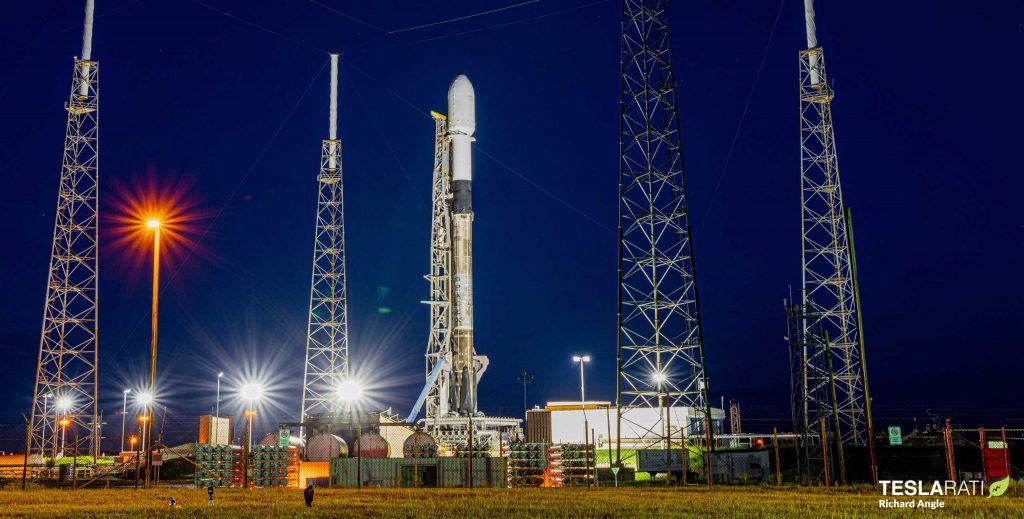

News
SpaceX Falcon 9 doubleheader still on track after fiery ULA launch abort
As previously reported by Teslarati, SpaceX announced intentions to launch two Falcon 9 missions from two Florida launchpads on Sunday, August 30th. However, the ambitious goal was left in limbo.
The record-breaking doubleheader was believed to hinge upon the Saturday morning launch of a United Launch Alliance (ULA) Delta IV Heavy rocket with a classified spy satellite. However, that is apparently no longer the case.
Instead of launching on time, ULA’s infrequently-flown heavy-lift rocket was hit by 72 hours of delays to rectify minor pad hardware bugs. Around 2 am EDT (UTC-4) on August 29th, Delta IV Heavy made it just seconds away from liftoff before the rocket’s autonomous flight computer detected an anomaly with pad hardware and aborted the launch. As a result, the three cores’ three Aerojet Rocketdyne RS-68A engines were forced to shut down after ignition – an uncommon Delta IV launch abort scenario that has historically required at least a week of work to recycle for another launch attempt.

ULA ultimately determined that it was not possible to recycle the countdown for another attempt although enough time remained in the launch window to do so. The launch vehicle was safed and a scrub was announced.
In a statement provided by ULA confirmed that the early shutdown was “due to an unexpected condition during the terminal count at approximately three seconds before liftoff.” ULA also confirmed that “the required recycle time prior to the next launch attempt is seven days minimum.”
ULA has to fly before SpaceX, right?
With a minimum of seven days required to recycle the ULA Delta IV Heavy for another launch attempt, it was unclear what that meant for the fate of the SpaceX SAOCOM-1B mission.

It was previously understood that in order for SpaceX to launch the SAOCOM-1B mission from nearby Space Launch Complex-40 (SLC-40), the ULA Delta IV Heavy would have to successfully launch first. The southern polar launch trajectory of the SAOCOM-1B’s mission is one that hasn’t been flown from Cape Canaveral, FL in nearly six decades. This particular flightpath includes launch hazard zones that inch ever so close to the launchpad of the Delta IV Heavy, which is currently still on its launchpad stacked with a classified payload for the U.S. government.
It was assumed that the Falcon 9 would suffer the same minimum delay of seven days, if not longer. However, on Saturday afternoon, August 29 a SpaceX media representative confirmed that the company was still targeting the historic double header launches on Sunday, August 30.
Double the launches, double the recoveries
If SpaceX can pull it off, Sunday is set to be a stellar day for Falcon 9 launches and landings. The SAOCOM-1B mission will feature a Return To Launch Site (RTLS) landing attempt of the expended Falcon 9 booster while the Starlink Falcon 9 booster is expected to land aboard the autonomous droneship “Of Course I Still Love You” currently stationed off the coast of South Carolina.
In an unusual move, SpaceX split up the fairing catching vessels. Initially, both vessels left Port Canaveral and headed south to a catch zone located between The Bahamas and Cuba in an attempt to catch both fairing halves of the SAOCOM-1B mission. Then, GO Ms.Tree did an about-turn and met up with the booster recovery vessels off the coast of South Carolina.
At the time of publishing, the two Sunday Falcon 9 launches are expected to occur just nine hours apart. The Starlink V1.0-L11 mission is slated to occur at 10:12am ET (1412 UTC) from Launch Complex 39-A at Kennedy Space Center while the SAOCOM-1B mission is set to launch at 7:18pm ET (2318 UTC) from SLC-40 at Cape Canaveral Air Force Station. As usual, SpaceX will host official launch webcasts live, typically beginning around 15 minutes before liftoff.
Check out Teslarati’s newsletters for prompt updates, on-the-ground perspectives, and unique glimpses of SpaceX’s rocket launch and recovery processes.
News
Tesla begins Robotaxi certification push in Arizona: report
Tesla seems serious about expanding its Robotaxi service to several states in the coming months.

Tesla has initiated discussions with Arizona transportation regulators to certify its driverless Robotaxi service in the state, as per a recent report from Bloomberg News. The move follows Tesla’s launch of its Robotaxi pilot program in Austin, Texas, as well as CEO Elon Musk’s recent comments about the service’s expansion in the Bay Area.
The Arizona Department of Transportation confirmed to Bloomberg that Tesla has reached out to begin the certification process for autonomous ride-sharing operations in the state. While details remain limited, the outreach suggests that Tesla is serious about expanding its driverless Robotaxi service to several territories in the coming months.
The Arizona development comes as Tesla prepares to expand its service area in Austin this weekend, as per CEO Elon Musk in a post on X. Musk also stated that Tesla is targeting the San Francisco Bay Area as its next major market, with a potential launch “in a month or two,” pending regulatory approvals.
Tesla first launched its autonomous ride-hailing program on June 22 in Austin with a small fleet of Model Y vehicles, accompanied by a Tesla employee in the passenger seat to monitor safety. While still classified as a test, Musk has said the program will expand to about 1,000 vehicles in the coming months. Tesla will later upgrade its Robotaxi fleet with the Cyercab, a two-seater that is designed without a steering wheel.
Sightings of Cybercab castings around the Giga Texas complex suggests that Tesla may be ramping the initial trial production of the self-driving two-seater. Tesla, for its part, has noted in the past that volume production of the Cybercab is expected to start sometime next year.
In California, Tesla has already applied for a transportation charter-party carrier permit from the state’s Public Utilities Commission. The company is reportedly taking a phased approach to operating in California, with the Robotaxi service starting with pre-arranged rides for employees in vehicles with safety drivers.
News
Tesla sets November 6 date for 2025 Annual Shareholder Meeting
The automaker announced the date on Thursday in a Form 8-K.

Tesla has scheduled its 2025 annual shareholder meeting for November 6, addressing investor concerns that the company was nearing a legal deadline to hold the event.
The automaker announced the date on Thursday in a Form 8-K submitted to the United States Securities and Exchange Commission (SEC). The company also listed a new proposal submission deadline of July 31 for items to be included in the proxy statement.
Tesla’s announcement followed calls from a group of 27 shareholders, including the leaders of large public pension funds, which urged Tesla’s board to formally set the meeting date, as noted in a report from The Wall Street Journal.
The group noted that under Texas law, where Tesla is now incorporated, companies must hold annual meetings within 13 months of the last one if requested by shareholders. Tesla’s previous annual shareholder meeting was held on June 13, 2024, which placed the July 13 deadline in focus.
Tesla originally stated in its 2024 annual report that it would file its proxy statement by the end of April. However, an amended filing on April 30 indicated that the Board of Directors had not yet finalized a meeting date, at least at the time.
The April filing also confirmed that Tesla’s board had formed a special committee to evaluate certain matters related to CEO Elon Musk’s compensation plan. Musk’s CEO performance award remains at the center of a lengthy legal dispute in Delaware, Tesla’s former state of incorporation.
Due to the aftermath of Musk’s legal dispute about his compensation plan in Delaware, he has not been paid for his work at Tesla for several years. Musk, for his part, has noted that he is more concerned about his voting stake in Tesla than his actual salary.
At last year’s annual meeting, TSLA shareholders voted to reapprove Elon Musk’s compensation plan and ratified Tesla’s decision to relocate its legal domicile from Delaware to Texas.
Elon Musk
Grok coming to Tesla vehicles next week “at the latest:” Elon Musk
Grok’s rollout to Tesla vehicles is expected to begin next week at the latest.

Elon Musk announced on Thursday that Grok, the large language model developed by his startup xAI, will soon be available in Tesla vehicles. Grok’s rollout to Tesla vehicles is expected to begin next week at the latest, further deepening the ties between the two Elon Musk-led companies.
Tesla–xAI synergy
Musk confirmed the news on X shortly after livestreaming the release of Grok 4, xAI’s latest large language model. “Grok is coming to Tesla vehicles very soon. Next week at the latest,” Musk wrote in a post on social media platform X.
During the livestream, Musk and several members of the xAI team highlighted several upgrades to Grok 4’s voice capabilities and performance metrics, positioning the LLM as competitive with top-tier models from OpenAI and Google.
The in-vehicle integration of Grok marks a new chapter in Tesla’s AI development. While Tesla has long relied on in-house systems for autonomous driving and energy optimization, Grok’s integration would introduce conversational AI directly into its vehicles’ user experience. This integration could potentially improve customer interaction inside Tesla vehicles.
xAI and Tesla’s collaborative footprint
Grok’s upcoming rollout to Tesla vehicles adds to a growing business relationship between Tesla and xAI. Earlier this year, Tesla disclosed that it generated $198.3 million in revenue from commercial, consulting, and support agreements with xAI, as noted in a report from Bloomberg News. A large portion of that amount, however, came from the sale of Megapack energy storage systems to the artificial intelligence startup.
In July 2023, Musk polled X users about whether Tesla should invest $5 billion in xAI. While no formal investment has been made so far, 68% of poll participants voted yes, and Musk has since stated that the idea would be discussed with Tesla’s board.
-

 Elon Musk1 week ago
Elon Musk1 week agoTesla investors will be shocked by Jim Cramer’s latest assessment
-

 Elon Musk3 days ago
Elon Musk3 days agoElon Musk confirms Grok 4 launch on July 9 with livestream event
-

 Elon Musk17 hours ago
Elon Musk17 hours agoxAI launches Grok 4 with new $300/month SuperGrok Heavy subscription
-

 News7 days ago
News7 days agoTesla Model 3 ranks as the safest new car in Europe for 2025, per Euro NCAP tests
-

 Elon Musk2 weeks ago
Elon Musk2 weeks agoA Tesla just delivered itself to a customer autonomously, Elon Musk confirms
-

 Elon Musk1 week ago
Elon Musk1 week agoxAI’s Memphis data center receives air permit despite community criticism
-

 Elon Musk2 weeks ago
Elon Musk2 weeks agoTesla’s Omead Afshar, known as Elon Musk’s right-hand man, leaves company: reports
-

 News2 weeks ago
News2 weeks agoXiaomi CEO congratulates Tesla on first FSD delivery: “We have to continue learning!”

















